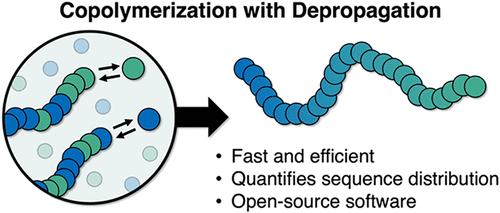Efficient Deterministic Modeling of Reversible Copolymerizations
IF 5.2
1区 化学
Q1 POLYMER SCIENCE
引用次数: 0
Abstract
Mathematical modeling of copolymerizations with depropagation remains significantly more challenging than those with only irreversible propagation. Current models require solving a system of nonlinear equations to calculate chain-end dyads at every integration step, which is inefficient and prone to numerical instability. This paper formulates the core species balances as a pure system of ordinary differential equations by directly integrating these chain-end dyad balances, increasing the computational efficiency by roughly an order of magnitude and improving the numerical stability. Two model systems of controlled polymerization with a single depropagating monomer and uncontrolled polymerization where both monomers undergo depropagation were studied and validated with stochastic simulation and experimental data, respectively. A model system approximating the controlled copolymerization of ethyl lipoate and n-butyl acrylate was analyzed by systematically varying accessible experimental conditions. The developed model was used to quantify the variation in average monomer sequence length along the polymer backbone. As temperature increases or concentration decreases, the resulting copolymer transitions from a highly gradient microstructure to an even monomer distribution, revealing accessible design handles that chemists can use to manipulate sequence. For uncontrolled polymerization, the high-temperature bulk copolymerization of α-methylstyrene and methyl methacrylate was simulated and accurately reproduces experimental conversion and composition profiles. The validation of time-resolved predictions of composition and sequence length under highly reversible conditions enables applications in process monitoring and optimization. In summary, this model demonstrates sophisticated predictions of sequence statistics while retaining both efficiency and stability even under conditions with significant reversibility or compositional asymmetry.

可逆共聚反应的高效确定性建模
反扩散共聚的数学建模比不可逆共聚的数学建模更具挑战性。目前的模型在每个积分步骤都需要求解一个非线性方程组来计算链端二叉,这是低效的,而且容易产生数值不稳定性。本文通过对这些链端二元平衡直接积分,将核心物种平衡表述为一个纯常微分方程组,使计算效率提高了大约一个数量级,提高了数值稳定性。通过随机模拟和实验数据,分别研究了单单体退传控制聚合和双单体退传控制聚合两种模型系统,并对其进行了验证。通过系统地改变可达到的实验条件,分析了一个近似于脂酸乙酯与丙烯酸正丁酯可控共聚的模型系统。所建立的模型用于量化聚合物主链上单体平均序列长度的变化。随着温度的升高或浓度的降低,共聚物从高度梯度的微观结构转变为均匀的单体分布,从而揭示了化学家可以使用的设计手柄来操纵序列。在无控聚合条件下,模拟了α-甲基苯乙烯和甲基丙烯酸甲酯的高温本体共聚,准确再现了实验转化率和组成曲线。在高度可逆的条件下,对成分和序列长度的时间分辨预测的验证使过程监控和优化的应用成为可能。总之,该模型展示了复杂的序列统计预测,即使在具有显著可逆性或成分不对称的条件下,也能保持效率和稳定性。
本文章由计算机程序翻译,如有差异,请以英文原文为准。
求助全文
约1分钟内获得全文
求助全文
来源期刊

Macromolecules
工程技术-高分子科学
CiteScore
9.30
自引率
16.40%
发文量
942
审稿时长
2 months
期刊介绍:
Macromolecules publishes original, fundamental, and impactful research on all aspects of polymer science. Topics of interest include synthesis (e.g., controlled polymerizations, polymerization catalysis, post polymerization modification, new monomer structures and polymer architectures, and polymerization mechanisms/kinetics analysis); phase behavior, thermodynamics, dynamic, and ordering/disordering phenomena (e.g., self-assembly, gelation, crystallization, solution/melt/solid-state characteristics); structure and properties (e.g., mechanical and rheological properties, surface/interfacial characteristics, electronic and transport properties); new state of the art characterization (e.g., spectroscopy, scattering, microscopy, rheology), simulation (e.g., Monte Carlo, molecular dynamics, multi-scale/coarse-grained modeling), and theoretical methods. Renewable/sustainable polymers, polymer networks, responsive polymers, electro-, magneto- and opto-active macromolecules, inorganic polymers, charge-transporting polymers (ion-containing, semiconducting, and conducting), nanostructured polymers, and polymer composites are also of interest. Typical papers published in Macromolecules showcase important and innovative concepts, experimental methods/observations, and theoretical/computational approaches that demonstrate a fundamental advance in the understanding of polymers.
 求助内容:
求助内容: 应助结果提醒方式:
应助结果提醒方式:


